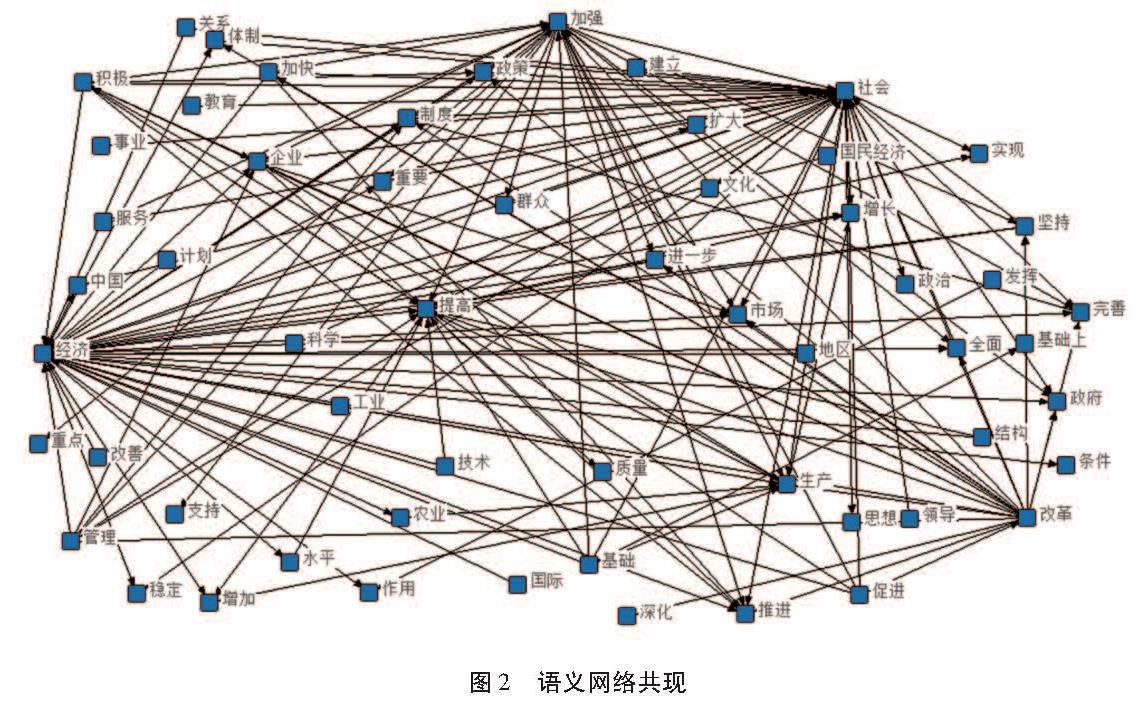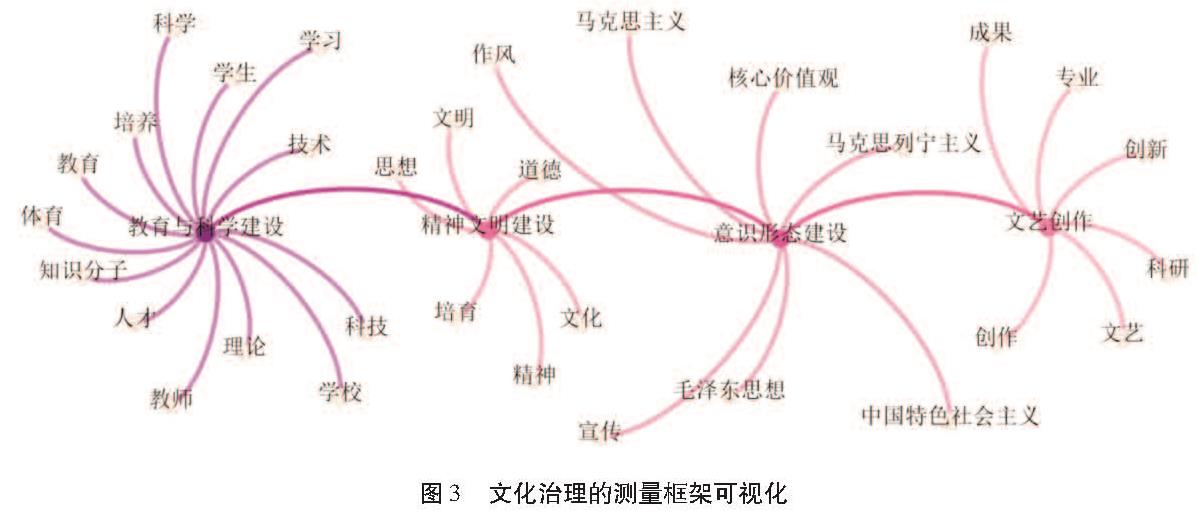(School of Public Administration, Fujian Normal University, Fuzhou 350117, China)
cultural governance; cultural power; Report on the Work of the Government
DOI: 10.15986/j.1008-7192.2022.04.009
备注
1 问题的提出
文化治理作为国家治理体系和治理能力现代化进程中的新命题,是“建成社会主义文化强国”时代背景下的重要战略举措[1]。党的十九大指出,文化是一个国家、一个民族的灵魂。溯及1997年,党的十五大第一次提出要“建设中国特色社会主义文化”,随即“文化治理”作为国家顶层设计的聚焦点获致鼎力发展。
新中国成立以来,历届党和国家领导人均以文化善治对于国家发展的津要作用进行论述。譬如,毛主席倡导将马克思主义文化大众化,认为应当把马列主义中有关文化的普遍原理和中国文化建设的具体情境相结合[2]。邓小平强调要“搞好物质文化建设和精神文明建设,改善人民的物质文化生活”[3]。习近平总书记亦鞭辟入里地指出,“体现一个国家综合实力最核心的、最高层的,还是文化软实力,这事关精气神的凝聚”[4],这亦是文化治理作为国家“五位一体”治理体系之一的应有之义。
尽管如此,文化治理的战略地位并非在新中国成立伊始就凸显,而是历经历史发展的凝练,直至十五大方才获致进阶推进。那么,应该如何看待新中国成立以来文化治理从普遍战略提升到顶层设计高度的历史沿革,从“忽视”到“重视”的注意力配置变化是理论界亟待解决的一个问题。
国内理论界持续关注文化治理的问题,且已取得诸多成绩。目前理论界对于文化治理的研究主要集中为三个向度:一是将新时代与文化治理相互联结。刘朝晖[5]从新时代社会主义文化治理体系和治理能力现代化的内生诉求出发,统合社会主义文化治理体系的方法论视野,藉此构建新时代社会主义文化治理体系的方法论策略。马俊峰等[6]就充分体认新时代文化的内涵、源泉以及实现途径进行了规范研究。周向军等[7]聚焦于习近平总书记有关文化治理的重要观点与论断来探索及回答新时代我国在文化治理层面的基本问题,譬如文化建设的战略地位、重点任务和基本原则等。欧阳雪梅[8]在党的十八大与十九大的时域间探寻习近平新时代中国特色社会主义文化治理在理论层维的“应然”及实践层维的“实然”上的创新变化。回溯了改革开放以来,中国特色社会主义在文化层维从改革开放初期到新时代间的建设历程[9]。二是重点关注改革开放以来的文化治理进展。刘彦武[10]基于中国文化治理主体、治理空间、治理方式与治理空间勾勒我国文化治理的变革路径。刘颖[11]对改革开放以来党的文化治理脉络进行梳理,从中总结党的文化治理经验。姬会然[12]以中国共产党十二大至十九大之间的历代党代会报告为研究样本,藉以解读改革开放以来的文化治理特点。郭远远等[13]基于对历年国务院政策文本的解读,围绕政策目标、功能定位和政策制定者的心理层面,定位于改革开放以来的文化治理演变路向与未来进路。三是对文化治理转进阶段的考据。新中国文化治理的历时周长远长于建国周长。在新中国成立前夕,文化治理已从酝酿阶段走向了摸索发展。理论界对于文化治理的阶段研究,存在着系列共识。理论界认为,文化治理的萌芽始于五四运动。五四运动是中国共产党对新民主主义文化治理探索的开端,而1940年《新民主主义论》的公开刊载揭示了新民主主义文化治理理论的正式形成[14]50-53。文化治理“深描”了在政治、经济、社会各个方面开展文化建设[15]。回溯文化治理的阶段转进,文化治理呈现由“新民主主义文化治理——社会主义文化治理——中国特色社会主义文化治理——新时代中国特色社会主义文化治理”的承继脉络。理论界多基于单个阶段分而论之,如李萍等[16]将我国文化治理的探索历程分为从“文化翻身”到“文化改造”,从“文化建设”到“文化改革”,从“文化兴国”到“文化强国”三个过程; 蔡武进[17]认为我国文化治理现代化可以分阶为“萌芽—起步—探索—推进—深化”五个时期; 刘军[18]关注习近平文化思想的世界视野、民族追求、人民主体和发展道路等四个倾向; 门献敏[19]关注毛泽东提出的系列中国社会主义文化建设方略; 刘旺旺[20]关注社会主义文化治理在“双百”方针、“二为”方向、“双创”方略等基本原则的历史及其适用边界。
上述三个向度的研究丰富了理论界对于文化治理的知识积累,解决了诸多理论迷思。但是,其研究时域几希涉及新中国成立以来文化治理演变,且研究方式多倾向于规范研究而实证研究阙如。据此理路,本研究致力于回答如下问题:(1)如何解释我国文化治理的逻辑理路?(2)我国文化治理具有怎样的政策特征?(3)这能为我国建成社会主义文化强国提供怎样的学理启发?
基于此,本研究藉以新中国成立以来的历届党代会报告和国务院政府工作报告为研究样本,引入ROST 软件和QSR NVivo 11质性研究工具进行规范的文本分析,测量新中国成立以来文化治理的注意力配置情况,获致一些对建成社会主义文化强国具有增益性的启发。
2 理论基础与研究设计
3 研究过程与结果
3.1 建立测量框架(1)构建测量维度。构建测量维度的前提条件在于对政策文件的充分解读。政策文件内容是多样化的,除了文化治理方面的描述,亦涵盖了经济建设、社会建设、生态建设等其他方面的词句。因此,需要对政策文件作政策内部关系图谱的解读。政策关系图谱旨在对政策文本内容的层次进行剖析,围绕研究问题将符合条件的文本内容抽取出来,构建研究问题专属“信息茧房”,以此排斥不相关文本内容的信息干扰。鉴于此,笔者逐一对每份政策文本作文化治理的政策关系图谱解读,从提取文本主题到结构层次细化,以图谱形式对文本内容的有效信息进行全面展示,明晰测量维度的构建择取。以《1979年政府工作报告》为例,对该政策文本作文化治理政策内部关系图谱绘制(图1),由图谱获知,该政策文本在“大结构”上分为“伟大的历史性转变、打好现代化第一个战役”等四个方维,每个方维均涉猎了文化治理的具化总结与指导。
本研究在对系列政策文本进行政策关系图谱的解读后,借鉴周向军等[35]、欧阳雪梅[36]的研究,构建四个层级的测量维度:(1)意识形态建设;(2)精神文明建设;(3)教育与科学建设;(4)文艺创作。
(2)关键词数据清洗。对政策文本中的关键词进行厘析,是注意力测量的先期步骤。本研究藉助ROSTNAT工具①进行关键词的数据清洗工作。首先,鉴于ROSTNAT工具仅兼容数据格式为txt格式,因此,事先将65份政策文本从doc文本格式转录为txt文本格式,以便于数据分词及词频统计。在统计词频的同时,对其语义网络共现图进行绘制。语义网络共现图可以判别词簇之间的联结关系,其将关键词中最具影响力的词汇,依据其中内在关联,从而联结起来。在语义网络共现图中,一个关键词就是一个独立的节点。联结线越密集的节点,其影响因子越大; 反之,联结线越稀疏的节点,其影响因子越弱。经过ROSTNAT工具,得到本研究的语义共现图(图2)。
观察图1可以体认到,虽然“经济”和“社会”节点具有重要影响作用,但亦可观察到,其与文化、思想、科学、技术、教育等节点有着联结关系,因此可以研判其与文化治理有着密切关联,这为构建与检验测量维度提供了路径。导入已完成转录的txt文本,进行词频统计,将符合测量维度的词汇逐一逐类归位,归类过程遵循文本分析共识:(1)尽可能保留原文字句,使用原文表述,而非自行主观提炼与组合新词字。(2)总词频表信息量大,包含内容涉猎政府职能、年度任务配置等多重内容,因此需反复逐一查摆,不遗漏符合测量维度的词字。经过筛选,得出汇总表(表1)。
需要说明的是,为了更加范畴化地表示关键词,本研究在不改变关键词原意的基础上,对同类词簇进行了必要的合并,以提升注意力测量质量。譬如,将“义务教育”“教育事业”和“职业教育”统称为“教育”。文化治理的测量框架可视化如图3所示。
3.2 文本编码为了简捷检视1949年以来文化治理的阶段性特征,考虑到政府工作报告及党代会报告是涉及全面的文本,其中对文化治理的描述局限于篇幅。因此,本研究以10年为分界线对政策文本进行内容合并以及注意力配置测量,具体时间分阶及对应为T1(1949—1958年)、T2(1959—1968年)、T3(1969—1978年)、T4(1979—1988年)、T5(1989—1999年)、T6(2000—2009年)、T7(2010—2021年)。
编码过程中,秉持“互斥”“逐行”的编码共识,对政策文本逐一研析,进行编码。当同一句式中,一个同义关键词即使出现多次,也仅限编码一次。若其存在不同意义指称,则进行复次编码,以此穷尽编码数据。经过测量,得出表2和图4。
3.3 注意力变迁及走向观察表2和图4,1949年以来的文化治理注意力演进情况,结合国家关涉文化治理的推进实践,本研究探寻到国家对于文化治理的注意力配置存有如下特征。
(1)新中国成立以降的文化治理总体连续延伸发展,T3是其显著的分界点。新中国成立以来的文化治理注意力总体变迁情况,可以从“嬗变轨迹”和“走向”两个方面来双向研析。统观新中国成立以来文化治理的嬗变轨迹,其注意力从T1的高位峰值呈现“断崖式”态势急遽下降,T3跌至历史低谷,而后以T3为分界点,反弹“爬坡”升格至T4,最终形成新的峰值。嗣后,文化治理总体趋向平衡发展,且稳步积淀走向深化。在文化治理的走向上,从T3至T7的曲线变化可以研判,尽管文化治理的各维度注意力比重配置仍存有差距,但是其差距在显著缩小,且总体趋向于平衡发展。这种走向得益于新时代对“文化自信”的津梁启迪。“坚定文化自信,推动社会主义文化繁荣和兴盛”作为新时代文化发展的战略目标[37],推动着“习近平新时代中国特色社会主义思想往心里走、往深里走、往实里走,切实以新思想孕育新精神,以新精神引领新时代伟大实践”[38]。
综合文化治理注意力“嬗变轨迹”和“走向”,结合相应时期政府政策的指向与践履,可从如下几个层面探究其演变原因。
第一,新中国成立初期的文化设计认为, 要从以1949年《中国人民政治协商会议共同纲领》(以下简称《共同纲领》)为指导的新民主主义文化过渡为社会主义文化需要经历一个过程[39],T1、T2、T3即是这样的一个探索如何建构社会主义文化的过程。《共同纲领》以新民主主义文化思想为指导,主要发展思想道德、文学艺术、科学、新闻出版、教育、社会科学、体育卫生等七种文化事业形态。在此指导下,新中国成立初期的文化治理在汇编文件文献、党和国家领导人报告讲话、文化类记叙与口述史料、报纸杂志宣传等方面产出丰厚[40]。
第二,1978年12月,改革开放的重大转折给文化治理带来了深远影响[41],党对中国特色社会主义的发展路径和方向有了较为明确的建设促动。文化治理重申继续“坚持百花齐放、推陈出新、洋为中用、古为今用的方针”[42]57。“双百”方针和“二为”方向获致政策袭用,助益完成了从社会主义文化治理到中国特色社会主义文化治理的创设和实践[43]84-127。
第三,自党的十八大将文化建设纳入中国特色社会主义建设“五位一体”总布局伊始,“文化”业已成为同“经济”“政治”“社会”与“生态文明”并重的“五位一体”基本要件。文化治理在“五位一体”的职能框架内担纲着先导作用,联结经济建设的关键作用、政治建设的保障作用、社会建设的归宿作用以及生态文明建设的根基地位[44],“五位”相互嵌套、密切联系为“一体”。
第四,“五年计划”作为我国“政策治国”的重要政策形态[45],在我国“文化治理”的发展里程碑中有促进作用。从“一五”到“十三五”,“文化”在“五年计划”文本中的词频比重也不断增加,尤其改革开放迄今,其词频比值变化更加明显(表3),特别是“十二五”和“十三五”对文化治理的词频比例远超过了以往词频比例。
词频的增加意味着“文化”在“五年计划”文本中的比例增加,对其投注了更多的注意力。其中,“十五”计划第一次提出“文化产业”概念,并且驱策“加强图书馆、博物馆、文化馆、科技馆和青少年活动场所等文化设施建设”。“十一五”计划第一次在提出“公共文化服务”概念,据以“逐步形成覆盖全社会比较完备的公共文化服务体系”。“十二五”计划进一步明确要求“推动文化产业成为国民经济支柱性产业”。
除了上述内容,值得注意的是,T3意识形态维度注意力投入达到历史最高峰。之所以如此,缘于两方面影响:一是T3所历经的历史事件使然,例如文化大革命对文化治理的梗阻与割裂。这一时期的文化治理注意力演变轨迹是同当时的政治目标联系在一起的[46]222。二是新中国成立初期,党将“使马克思主义成为被广大人民认同的主流意识形态”作为文化领域所归趣的奋斗目标。捍卫社会主义意识形态,成为坚守社会主义核心价值体系的主要内容[47]215。
(2)精神文明维度的建设愈加成熟。精神文明维度的建设在趋向上有明显的波动,在T4前期趋于不稳定,嗣后则迈向成熟。溯思自1979年9月的新中国成立30周年庆祝大会,叶剑英第一次提出了“社会主义精神文明”的概念[48]。嗣后,1982年党的十二大对“努力建设高度的社会主义精神文明”作出了独立阐述,建立什么样的社会主义精神文明及怎么样建立社会主义精神文明得到政策理据支撑。在延续之前政策基础上,党的十七届六中全会作出颁布了《中共中央关于深化文化体制改革推动社会主义文化大发展大繁荣若干重大问题的决定》, 首次明确提出了“建设社会主义文化强国”的战略目标,文化治理由此步入阔步发展时期。2005年,中共中央、国务院印发《关于深化文化体制改革的若干意见》,推进文化治理在目标任务、原则要求、基本思路等层面全方位部署,文化体制改革全面推开,以期促进文化创新的水准提升。
精神文明维度已成为新时代的常态建设,以“富强、民主、文明、和谐,自由、平等、公正、法治,爱国、敬业、诚信、友善”为基本内容的社会主义核心价值观深入人心,对于文化治理在理论与实践之间搭建环路起助益作用。在习近平的文化思想中,更是以“文化立国”的战略高度,将文化视作推动社会发展的重要手段,以及社会文明进步的重要目标,把文化上升到引领文明进步的高度[49]。
(3)文艺创作在T2发展较薄弱,但总体日臻繁荣。文艺创作在趋向上总体呈现渐进状态。新中国成立初期“双百”方针极大激发了文艺工作者的创作活力,成为国内科学文化治理的基本方略。此外,可以显著观察到,文艺创作在T2较为薄弱,究其缘由在于,“大跃进”运动及三年饥荒等造成的经济困难迫使国家及人民的注意力全面聚焦于经济层面,优先着手解决温饱问题,而暂时放缓其他维度的建设,在一定程度上束缚了文艺生产力。在扛过系列难关之后,党日益重视文艺创作的数量与质量,出台了系列政策举措鼓励文艺创作。1979年10月,邓小平为第四次文代会致祝词,指出国家“在建设高度物质文明的同时,提高全民族的科学文化水平”,至此迎来了文化蓬勃发展的春天[50]4。
党的十九大报告提出,中国特色社会主义进入新时代,这是习近平新时代文化自信思想的时代背景,也是我们思考文化自信的历史方位[51]。在新时代,新媒体的出现助推大量原创文艺创作的作品诞生,在音视频上的创作,更是达到了历史峰值。在信息繁杂的互联网时代,新媒体阵营快速更新迭代,文化传播从纸面走向可视化,新媒体成为文化传播的新载体,是文化治理不容忽视的重要组成部分。党的十九届五中全会审议通过的《中共中央关于制定国民经济和社会发展第十四个五年规划和二〇三五年远景目标的建议》提出要在2035年建成文化强国,这是文化自信的深刻体现,展现大国创造辉煌的充沛底气。
(4)教育与科学建设在全貌上稳中有升,连续而渐进。新中国成立伊始,第一次全国教育工作会议提出了“推行识字教育,逐步减少文盲”的口号。扫盲运动所掀起的三次识字高潮,促使国民教育开始起步。1986年,党中央正式施行《中华人民共和国义务教育法》,提出2000年全面推行九年义务教育。1987年党的十三大指出,“把科学技术和教育放在首要位置,使经济建设转到依靠科技进步和提高劳动者素质的轨道上来”。党的十五大指出,教育要面向现代化、面向世界、面向未来,并且将此列为社会主义初级阶段文化治理的整体战略。1999年,《中共中央国务院关于深化教育改革全面推进素质教育的决定》特别强调,“实施素质教育就是全面贯彻党的教育方针”,为坚持教育优先和推进素质教育提供政策依据。党的十六届四中全会明确提出要“深化文化体制改革,解放和发展文化生产力”,映射了党对文化治理的认知更加深入。在新时代,“双一流”政策下的高校建设进一步促进教育质量的升级。上述施政思想的落地施行,极大促进了教育和科学建设的进步。
新中国成立以来,教育作为国之大计,尤其是本硕博教育,国家持续倾注了政策注意力。高等教育的规模和质量在“生源扩招”“985、211工程”“双一流工程”等政策举措的促动下“双向”扩展,教育资源总体从匮乏走向繁盛,教育质量亦逐步跻入全球排行。据第九年度世界大学学科排名显示,我国有402个学科进入世界百强行列,位列世界第三。2016年5月,习近平在北京主持召开哲学社会科学工作座谈会,加快建设社会主义文化强国、增强文化软实力、提高我国在国际上的话语权,迫切需要哲学社会科学更好地发挥作用[52]。2020年10月,党的十九届五中全会提出把科技自立自强作为国家发展的战略支撑,深入实施科教兴国战略和人才强国战略,加快建设科技强国。
4 研究结论与政策启迪
4.1 研究结论
运用文本分析方法,结合1949年以来的相关政策文本,对1949年以来文化治理注意力配置情况进行了探索性研究。研究创新在于,跳出了传统的规范研究视角,转而从质性研究的视域来审视文化治理的注意力变迁。
研究发现,新中国成立以来文化治理的注意力配置呈现四个特征:首先,在总体趋势上,新时代文化治理相较于新中国成立初期,取得极其显著的硕果,注意力在时序上的变迁连续延伸推进,虽然在具体维度有所波动,但在全貌上呈现出深化倾向。其次,精神文明维度的建设在改革开放后日益迈向成熟。改革开放后,国家从原先的偏重物质文明转向了物质文明和精神文明两手抓。精神文明作为人的实践活动的内化,逐步在促进时代精神的伟大转变[53]。再次,文艺创作维度的注意力配置从探索到渐入稳定。文艺创作维度的注意力从T1不足4%到T7的近10%,虽然其注意力赋值相较其他维度偏小,但在自身趋向上,处于连续不间断,且赋值趋于加强的渐入稳定状态。最后,教育与科学建设维度的注意力连续而渐进。教育与科学建设维度在走向上呈现近似斜直线的演进状态,在注意力比重上呈现稳步递增趋势,从T1(19.94%)到T7(28.04%)逐年累层增加,但增幅相对较小。
总之,新中国成立以来文化治理的注意力变迁体现了其注意力比值在应然理论与实然实践的“双维”上均步入新的一个台阶,从新中国成立初期的“文化治理意识”到“文化自信提升”,大大迥异和远超新中国成立初期的发展程度。
研究藉助政策文本研究以窥探文化治理的注意力变迁及研判其走向,在一定程度上确能从政策话语的变化观照文化治理的注意力端倪,但在政策样本的选择上囿于国务院《政府工作报告》和历届党代会报告,未容纳其他政策文本,从这方面来说,难免“挂一漏万”未能发掘全部的政策倾向,故只能“窥见一斑”,而不能窥其全貌。但即便如此,依然不妨碍我们对政策文本的透视与解读。
4.2 政策启迪
承继上述,我国文化治理的注意力配置优化可从如下几个路径展开。
(1)重点加强意识形态建设和文艺创作。意识形态建设和文艺创作在新中国成立以来的注意力配置上比重较低,两者均亟须得到重点加强。在意识形态建设上,党的十七大报告第一次提出了“增强社会主义意识形态的吸引力和凝聚力”,体现了国家对于意识形态建设的重视地位升级。意识形态建设关涉着文化前进方向和发展道路,以社会主义意识形态为核心的宣传思想工作将成为未来国家文化治理核心内容[54]。习近平总书记指出,建设具有强大凝聚力和引领力的社会主义意识形态,是全党特别是宣传思想战线必须担负起的一个战略任务[55]。2016年党的十八届六中全会,将“全党必须牢固树立政治意识、大局意识、核心意识、看齐意识”载入了《关于新形势下党内政治生活的若干准则》,成为继2012年“四个自信”后,对中国特色社会主义核心要义的意蕴丰富。在文艺创作上,创作成果是文化治理成果的输出载体,是一个从“无形”到“有形”再影响“无形”的思想传播过程。繁荣的文艺创作起着“温暖人、鼓舞人和启迪人”[56]的文艺力量,利于提升人民的文化修养和丰富文化生活的作用。
(2)继续加大对文化治理的注意力投入。党的十九大报告明确指出,中国特色社会主义文化源自中华民族五千多年文明历史孕育的中华优秀传统文化。文化治理在中国特色社会主义的重要意义固不待言,文化治理注意力的持续投入助益中华优秀传统文化的延承及升华。此外,通过解放和发展文化生产力,繁荣发展文化事业和文化产业,提高国家文化软实力,为如期建成社会主义文化强国、展现中华文化崭新气象奠定坚实基础。
(3)更加强调教育与科学建设。教育作为提升全民文化水平和培育国家人才的重要途径,是对未来的“智慧投资”和规划。习近平总书记在全国教育大会上强调要“坚持中国特色社会主义教育发展道路,培养德智体美劳全面发展的社会主义建设者和接班人”。因此要坚持创新在我国现代化建设全局中的核心地位,深刻理解把握时代潮流和国家需要,继续深入实施科教兴国战略、人才强国战略及创新驱动发展战略,以全面提高人才培养能力为重点,完善国家教育和创新体系,推动“建成社会主义文化强国”这一宏伟目标的实现。
注释:
① ROST NAT工具是清华大学新闻研究中心研发的一款大数据分析工具,可以实现政策文本数据的词频统计、文本分词以及社会网络分析等多维功能,业已成为理论界常用的质性分析工具。
注:资料来源:图1来源于《1979年政府工作报告》,图2来源于ROSTNAT工具自动分析结果,表1来源于研究样本,表3来源于历次五年计划(不含目录页),其余图表为作者自绘、自制。
2.1 理论基础文化治理(culture governance)概念缘起于20世纪后半期,初始见诸台湾学界论文,嗣后演扩成为学术研究的关键词。其旨在社会文化建设的过程中,在宪政体制和相关法规指导下,多元文化建设主体(政府、社会和市场)通过平等参与审议的方式,对社会文化发展的决策与法规、公民文化权益的保护和文化产品及服务的交换等相关问题基于公共理性而取得一致认同,并使管理主体在此基础上既能各施其责又能相得益彰,共同推进文化的大发展大繁荣的实践过程[21]。
注意力分配(attention allocation)概念的渊薮在于心理学领域,原指称“心理层面的可选择性、转移性与可分解性的集中与聚焦状态”[22]16,后经西蒙(Herbert A.Simon)引介于公共管理领域,并将其界定为“决策者在制定政策过程中,有选择地关注某些信息而忽略该信息以外的部分”[23]73-77。在西蒙研究的基础上,奥卡西奥(Ocasio W)提出了注意力基础观[24],认为注意力分配研究涵括注意力视角、企业行为视角、生态组织学视角、管理认知视角和议程设置视角等五种视角,进一步论证了决策者注意力对政策制定的影响作用。此后,注意力分析在观照政策发展进路等方面得到理论界的广泛研究运用。
政府决策是始自决策者的注意力聚焦而产生决策动机,最后落实决策行为的过程[25]。注意力分配对政府的行为选择有着至关重要的作用,是分析政府行为和政府决策的重要中介变量[26]。政策文本是政策存在的物理载体,作为政治仪式的符号,具有价值宣示功能[27]。
鉴于此,研究基于注意力分析,选择1949年以来有关政策文本为样本,采用ROST与QSR NVivo11质性研究软件对样本做文本分析,在运用ROST软件建立多级词频库的基础上界定测量维度,添加节点并进行对应编码,力图测量文化治理在1949年以来的注意力变化轨迹和特点,以期分析顶层设计对文化治理的关注程度,解释顶层设计推进发展文化治理的内在逻辑,进而为文化治理的未来进路提出增益性意见。
2.2 研究设计(1)政策文本的采集。本研究选取的政策文本为两类:一是新中国成立以来历届党代会报告,二是新中国成立以来的历年国务院《政府工作报告》。之所以选择其作为研究样本,是基于如下理据的考量:一是政策文件是政府表达政策意图和政策过程的客观凭证[28]2-50,党代会报告及国务院政府工作报告中内嵌的是对文化治理的统筹规划。二是这两类公开政策文件易在中央政府官网(http://www.gov.cn)专栏查询,且政策文本完整度较高。三是政府政策文件在制定过程上,有着严格的流程规范。在内容编制上,有着字句精准的严苛要求。一个政策文件从制定到颁发,甚至需要耗费长时间的实地调研以及经过层层领导的把关审核方能完成编制,因此,政策文件所内嵌的政治意蕴非常显著。
需要说明的是,出于历史缘由,《政府工作报告》在1961—1963年、1965—1974年及1976—1977年暂未进行编制。因此,本研究所涉研究总样本为65份,其中53份《政府工作报告》,12份党代会报告。文本字数合计1 409 290字。
(2)文本分析法。文本分析法(text analysis)属于一种基于质性研究的量化分析法,其“基于社会科学目的,适用于任何文本(或其他符号材料)的测度”[29]12-13。文本分析法最初用于传播学,嗣后被引荐于情报学及信息科学领域[30],近年来被逐步引进公共政策研究领域。
文本分析法通过将文本信息转换为可量化的信息,从而测量得出经验性的数据和结论[31]。“政策文本”是政策的载体,是公开的公文[32]。文本信息之间存在大量的链接和引用关系[33],使用文本分析方法对政府政策文本涉及的主题类别、主体构成、文种分布等指标做测量,可以从中研析政府的工作重心,挖掘其阶段性特征,从而分析演进趋向。政策文本作为政府政策执行的依据,研究政策文本“能够挖掘政策潜在语义和元政策要素,从政策价值、政策倾向等高度评价或比较不同时期的政策差异,更好地跟踪政策扩散过程”[34],将政策文本纳入文本分析法已成为公共政策研究的一个重要方向。
本研究通过文本分析法对文化治理历程进行客观、系统与量化的描述,适合于对政府相关政策的文本构成做解析,从而解释文化治理的历史变迁与重要特征。
- [1]李少惠,赵军义.公共文化服务研究的热点主题与演化路径分析[J].图书与情报,2017(4):122-129,71.
- [2]左伟清,刘尚明.论“当代中国马克思主义大众化”[J].中国特色社会主义研究,2008(1):27-32.
- [3]潘丽文,万欣荣.新时代“美好生活”话语的生成逻辑及其实质意蕴[J].江西财经大学学报,2019(1):3-12.
- [4]袁梅,刘玉杰.改革开放四十年我国民族教育政策价值取向的演进[J].西南民族大学学报(人文社科版),2019(4):214-219.
- [5]刘朝晖.新时代文化治理体系建构的方法论[J].宁夏社会科学,2019(1):5-11.
- [6]马俊峰,马乔恩.新时代文化自信的内涵、源泉及实现路径[J].学术交流,2018(4):58-64.
- [7]周向军,李国泉.新时代我国文化建设基本问题的创造性探索与回答——习近平总书记关于文化建设重要论述的内涵及其贡献[J].山东大学学报(哲学社会科学版),2019(2):1-10.
- [8]欧阳雪梅.新时代中国特色社会主义文化建设的理论与实践创新[J].党的文献,2019(1):13-20.
- [9]欧阳雪梅.改革开放40年中国文化建设的成就[J].国家行政学院学报,2018(6):73-77,189.
- [10]刘彦武.改革开放以来我国文化治理的变迁[J].中华文化论坛,2016(7):147-154,191-192.
- [11]刘颖.改革开放以来党的文化治理经验及时代运用[J].中共福建省委党校学报,2017(2):30-35.
- [12]姬会然.社会主义文化建设40年:基于八次党代会报告文本的分析[J].贵州社会科学,2018(8):11-17.
- [13]郭远远,陈世香.改革开放40年来文化建设定位的历史演变与未来展望——基于历年国务院政策文本的分析[J].中南大学学报(社会科学版),2018,24(1):127-135.
- [14]孙成武. 中国共产党文化建设史论[M]. 北京:人民出版社,2013.
- [15]廖胜华.文化治理分析的政策视角[J].学术研究,2015(5):39-43.
- [16]李萍,李增添.中国共产党文化治理方略的历史探索[J].广东社会科学,2020(5):5-14.
- [17]蔡武进.我国文化治理现代化70年:历程和走向[J].深圳大学学报(人文社会科学版),2020,37(3):25-35.
- [18]刘军.习近平新时代中国特色社会主义文化思想的四个维度[J].中共福建省委党校学报,2018(1):49-54.
- [19]门献敏.毛泽东社会主义文化建设思想的特质及其启示[J].思想理论教育导刊,2016(10):81-84.
- [20]刘旺旺.社会主义文化建设若干基本原则的历史与边界分析[J].江苏大学学报(社会科学版),2018,20(2):6-12.
- [21]陈怀平,吴绒,刘吉发.权力边界与职责担当:文化治理的“三元”主体格局建构——基于协商民主的视角[J].社会主义研究,2015(3):89-94.
- [22]贝斯特.认知心理学[M].黄希庭,译.北京:中国轻工业出版社,2000.
- [23]SIMON H A.Administration Behavior: A Study of Decision-making Process in Administrative Organization[M].New York: Free Press,1947.
- [24]OCASIO W. Towards an attention-based view of the firm[J]. Strategic Management Journal,1997,18(1):187-206.
- [25]文宏, 杜菲菲. 注意力、政策动机与政策行为的演进逻辑——基于中央政府环境保护政策进程(2008—2015年)的考察[J]. 行政论坛, 2018(2):81-84.
- [26]代凯. 注意力分配:研究政府行为的新视角[J]. 理论月刊, 2017(3):107-112.
- [27]黄萃,任弢,张剑.政策文献量化研究:公共政策研究的新方向[J].公共管理学报,2015,12(2):129-137.
- [28]李钢, 蓝石.公共政策内容分析方法:理论与应用[M].重庆:重庆大学出版社,2007.
- [29]SHAPIRO G. Text Analysis for the Social Sciences: Methods for Drawing Statistical Inferences from Texts and Transcripts[M]. NJ: lawrence erlbaum associates, 1997.
- [30]CARLEY K M.Extracting team mental models through textual analysis[J]. Journal of Organizational Behavior, 1997,18(S1):533-558.
- [31]刘紫玟,尹丹,黄庆旭,等.生态系统服务在土地利用规划研究和应用中的进展——基于文献计量和文本分析法[J].地理科学进展,2019,38(2):236-247.
- [32]李江,刘源浩,黄萃,等.用文献计量研究重塑政策文本数据分析——政策文献计量的起源、迁移与方法创新[J].公共管理学报,2015,12(2):138-144,159.
- [33]马创新, 陈小荷.文本的可视化知识表示[J]. 情报科学, 2017(3):122-127.
- [34]裴雷, 孙建军, 周兆韬. 政策文本计算:一种新的政策文本解读方式[J].图书与情报, 2016(6):47-55.
- [35]周向军,李国泉.新时代我国文化建设基本问题的创造性探索与回答——习近平总书记关于文化治理重要论述的内涵及其贡献[J].山东大学学报(哲学社会科学版),2019(2):1-10.
- [36]欧阳雪梅.新时代中国特色社会主义文化建设的理论与实践创新[J].党的文献,2019(1):13-20.
- [37]马俊峰,马乔恩.新时代文化自信的内涵、源泉及实现路径[J].学术交流,2018(4):58-64.
- [38]储著源.论“为人民提供精神指引”[J].理论月刊,2019(4):19-25.
- [39]杨俊.论新中国成立初期中国共产党领导新文化建设的历史实践[J].马克思主义研究,2018(12):84-93.
- [40]储著武.新中国初期文化史述略[J].重庆社会科学,2015(2):111-121.
- [41]俞思念.改革开放以来中国文化建设的历程与前景[J].毛泽东邓小平理论研究,2008(11):31-35,84.
- [42]中共中央文献研究室.邓小平年谱(1975-1997):上[M].北京:中央文献出版社,2004:573.
- [43]孙成武. 中国共产党文化建设史论[M].北京:人民出版社, 2013.
- [44]蔡守秋.论我国法律体系生态化的正当性[J].法学论坛,2013,28(2):5-20.
- [45]王磊,乐园.条件约束下的中国发展道路——从十个五年计划看“中国之路”[J].河北学刊,2006(2):154-159.
- [46]孟宪平. 嬗变与重组:转型期社会主义文化建设机制研究[M].北京:人民出版社,2014.
- [47]孟宪平. 嬗变与重组:转型期社会主义文化建设机制研究[M]. 北京:人民出版社, 2014.
- [48]中共中央文献研究室.三中全会以来(上)[Z].北京:人民出版社,1982.
- [49]范玉刚.习近平文化思想深刻意涵[J].人民论坛,2014(24):18-21.
- [50]蔡武. 改革 发展 繁荣:改革开放30年中国文化发展报告[M]. 北京:文化艺术出版社,2008.
- [51]刘波.习近平新时代文化自信思想的时代意涵与价值意蕴[J].当代世界与社会主义,2018(1):97-104.
- [52]习近平.习近平在哲学社会科学工作座谈会上的讲话[EB/OL].[2016-05-18].http://www.xinhuanet.com//politics/2016-05/18/c_1118891128.htm.
- [53]邹诗鹏.现时代精神生活的物化处境及其批判[J].中国社会科学,2007(5):54-63.
- [54]郭远远,陈世香.改革开放40年来文化建设定位的历史演变与未来展望——基于历年国务院政策文本的分析[J].中南大学学报(社会科学版),2018,24(1):127-135.
- [55]习近平.习近平出席全国宣传思想工作会议并发表重要讲话[EB/OL].[2018-08-22].http://www.gov.cn/xinwen/2018-08/22/content_5315723.htm.
- [56]丁晓平.培根铸魂重于泰山[N].中国文化报,2019-05-08(03).







